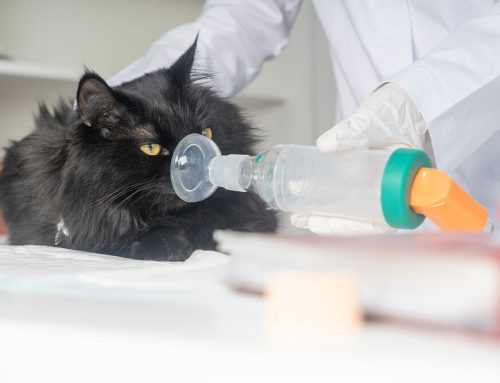September is Happy Cat Month, a time to celebrate our feline companions and promote their well-being. At Valley Center Veterinary Clinic, we believe that a happy cat is a healthy cat. Here’s your comprehensive guide to keeping your beloved cat purring with contentment.
Understanding Your Cat’s Needs
Cats may seem independent, but they rely on us for their happiness and overall well-being. Beyond basic needs like food, water, shelter, and basic medical care, cats have specific requirements that contribute to their physical and emotional health. These include:
- Environmental Enrichment: Cats need a stimulating environment that allows them to express natural behaviors like climbing, scratching, and hiding.
- Companionship: While cats are often perceived as solitary, they do enjoy and benefit from social interaction, both with humans and sometimes with other pets.
- Mental Stimulation: Engaging your cat’s mind through play, puzzle feeders, and varied experiences helps prevent boredom and associated behavioral issues.
- Physical Activity: Regular exercise is crucial for maintaining a healthy weight, muscle tone, and overall fitness.
By addressing these needs, you’re setting the foundation for a happy, healthy cat.
Nutrition and Hydration
A balanced diet and fresh water are crucial for your cat’s health. The right nutrition supports your cat’s immune system, maintains a healthy coat, and provides energy for daily activities. Here are some key points to consider:
- Consult our veterinarians to determine the best diet for your cat’s specific needs, taking into account factors like age, weight, and any health conditions.
- Provide high-quality cat food appropriate for your cat’s life stage (kitten, adult, senior).
- Be mindful of portion sizes to prevent obesity, a common health issue in cats.
Encourage proper hydration by:
- Providing multiple water sources that are separate from food sources
- Experimenting with different bowl types, or even running water fountains which many cats prefer
- Adding flavor to water (e.g., low-sodium chicken broth) to entice picky drinkers
- Incorporating wet food into your cat’s diet, which can be an excellent source of hydration while keeping their weight in check.
Remember, proper hydration is essential for kidney function, digestion, and overall health.
Regular Health Check-ups
Routine veterinary visits are essential for early detection of health issues throughout your cat’s life. At Valley Center Veterinary Clinic, we recommend annual check-ups for adult cats and twice-yearly visits for senior cats or those with chronic conditions.
We offer Diagnostics and Dental Care services to identify and address potential problems before they escalate. These services include:
- Comprehensive physical examinations
- Blood work and urinalysis to check organ function and detect early signs of disease
- Dental cleanings and examinations to prevent periodontal disease
- Vaccinations to protect against common feline diseases
Regular check-ups allow us to monitor your cat’s health over time and provide personalized advice on nutrition, behavior, and preventive care.
Creating a Cat-Friendly Environment
To thrive, cats need an environment that stimulates their natural instincts. Here’s how you can create a cat-friendly home:
- Vertical Territory: Provide cat trees, shelves, or window perches for climbing and observing. This satisfies their natural instinct to seek high vantage points and can reduce stress in multi-cat households.
- Scratching Posts: Offer various textures (sisal, carpet, cardboard) and orientations (vertical, horizontal, angled) to satisfy their scratching and marking instinct. This also helps maintain claw health.
- Hideaways: Create cozy retreats for your cat to feel safe and secure. This could be a cat bed, a cardboard box, or a quiet corner with a soft blanket.
- Window Views: Allow safe outdoor viewing for entertainment. Consider setting up a bird feeder outside for added visual stimulation.
- Litter Box Setup: Provide multiple, easily accessible litter boxes in quiet locations. The general rule is one box per cat, plus one extra.
When you bring your cat in for medical appointments, you can see how our Cat-Friendly Practice protocols also use environmental elements to ensure a stimulating and low-stress visit.
Mental and Physical Stimulation
Keeping your cat mentally and physically active is crucial for their overall well-being. Here are some ways to keep your cat engaged:
- Interactive toys: Feather wands, laser pointers (used responsibly), and crinkly toys can simulate hunting behavior.
- Puzzle feeders: These challenge your cat’s problem-solving skills and make mealtime more engaging.
- Daily playtime sessions: Set aside time each day for interactive play with your cat.
- Climbing structures: Cat trees, wall-mounted shelves, and scratching posts encourage physical activity.
- Varied play styles: Incorporate chasing, pouncing, and batting to target different natural behaviors.
Regular exercise keeps feline minds active, maintains a healthy weight, and can prevent obesity-related health problems like diabetes and joint issues.
Recognizing Signs of Unhappiness
Cats are masters at hiding discomfort, so it’s important to be alert to subtle changes in your cat’s behavior that might indicate unhappiness or health issues. Watch for:
- Altered eating or litter box habits
- Excessive grooming or changes in grooming behavior
- Increased vocalization or aggression
- Hiding more than usual
- Lethargy or disinterest in play
- Changes in sleep patterns
- Unusual postures or facial expressions
If you notice these signs, seek veterinary advice. Our Emergencies page provides information on when to seek immediate help.
Addressing Behavioral Issues

Common problems like scratching furniture or spraying urine often indicate unmet needs or stress. Here are some solutions:
- Providing appropriate scratching posts and training your cat to use them
- Maintaining a clean litter box in a quiet, accessible location
- Offering plenty of playtime and environmental enrichment
- Using calming pheromone products during times of anticipated stress or change
- Ensuring each cat in multi-cat households has access to resources without competition
Conclusion
Keeping your cat happy involves understanding their unique personality, providing a stimulating environment, and staying attentive to their physical and emotional needs. By following these guidelines and seeking regular veterinary care, you can help your cat live a long, healthy, and fulfilling life.
For personalized advice or to schedule an appointment, contact Valley Center Veterinary Clinic today. Visit our Blog for more cat care tips.
For additional insights, check out our articles on Creating a Cat-Friendly Home and Managing Stress in Cats.
Remember, a physically and mentally healthy cat is a happy cat, and we’re here to support you in providing the best care for your feline friend. Happy Cat Month is the perfect time to reassess your cat’s needs and make any necessary changes to enhance their well-being. Here’s to many more years of purrs, head bumps, and feline companionship!







Leave A Comment